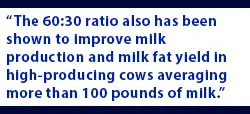
Choose your best strategy for fat supplementation
 By Marin Western
By Marin Western
“Components are king” and changes in the milk fat markets in recent years have driven a lot of new research on fat supplementation.
I am often asked, “What fat should I feed on my farm?” Frustratingly, my answer is, “It depends.” Research has shown us that all cows are not the same and the right strategy is to target different fatty acids to different groups based on stage of lactation and milk production.
No longer do we consider fat just fat. Current research on fat supplementation to lactating dairy cows is focused on individual fatty acids. Recent studies at Michigan State University have especially highlighted the impacts of individual fatty acids and how we can better utilize the commercial products available to us in the industry.
Fresh and early lactation cows: A 2017 study by Jonas de Souza and Dr. Adam Lock, Michigan State University, showed that feeding 80% palmitic acid at 1.5% diet dry matter (DM) in the fresh period improved energy-corrected milk production by more than 10 pounds. However, a greater bodyweight loss was recorded with these fresh animals. The same research group completed another study with a blend of 60% palmitic and 30% oleic acids in the supplemented fat. These fresh animals ate more feed, had higher energy-corrected milk, and did not lose as much condition as cows fed a greater proportion (80%) of palmitic acid.
 High-producing cows: The 60:30 ratio also has been shown to improve milk production and milk fat yield in high-producing cows averaging more than 100 pounds of milk.
High-producing cows: The 60:30 ratio also has been shown to improve milk production and milk fat yield in high-producing cows averaging more than 100 pounds of milk.
Mid- to late-lactation cows: In a 2018 study published by de Souza, a blend of palmitic and oleic fatty acids raised total fatty acid digestibility and bodyweight in post-peak cows. Late-lactation cows and cows producing less than 100 pounds benefitted more from an 80% palmitic acid and 10% oleic acid blend.
Return on investment
When looking at the value of milk, each tenth of a pound of milkfat (in the U.S. Mideast) is worth about $0.16 while 1 pound of milk is worth $0.17. Much of the previous research has seen at least a tenth of a percent bump in milkfat and 3 pounds of milk, totaling nearly $0.70 in increased production.
Feeding fat does have a cost, which can be up to $0.50 per cow per day when feeding 1.5% diet DM of fatty acids. Despite the higher cost, feeding fat can still be a worthwhile investment. Other benefits from feeding fat that are not included in those measurements are improvements in the health and productive life of the cow.
Which fat should I feed?
This comes back to my original answer of “it depends.” This recent research pointed us in the direction of targeting different groups of cows to maximize the benefit of fatty acid supplementation.
A common misconception is that many fatty acid products are pure, but that’s not the case. For example, even though calcium salts are used to provide oleic acid, they are made up primarily of palmitic acid. Understanding the level of fatty acids in the product being used is important to achieve the proper blends.
Other commercially available products provide these fatty acids in the correct ratios. If you can’t find these or are looking for another way to achieve the ratios, you can make blends of other available products. It is often less expensive to achieve the correct ratios by blending fatty acid products into a protein or mineral mix on the farm. Your Vita Plus consultant can help you evaluate what strategy makes the most sense for your farm and feeding program.
Income over feed cost is a vital metric to track, evaluate and decide whether you made the right decision. Re-evaluating current fat-feeding strategies or adding a fatty acid blend on your operation can help the bottom line and make your farm more profitable.
This article was originally written for the September 10, 2020 issue of Hoard’s Dairyman.
About the author: Marin Western is a Vita Plus dairy specialist in central Michigan. She earned her bachelor’s degree in animal science and agribusiness management at Michigan State University. She continued there to earn her master’s degree in dairy nutrition through the Vita Plus Dairy Nutrition and Management Fellowship. Part of her fellowship research focused on dairy cow production responses to different fat supplements. As an undergraduate student, Western worked at a Vita Plus intern and performed research focused on the critical analysis of bacteria and various spoilage agents in forages.
| Category: |
Dairy Performance Feed additives Feed quality and nutrition Milk production and components Transition and reproduction |

